Impact of Thermal Mass, Window Performance, and Window–Wall Ratio on Indoor Thermal Dynamics in Public Buildings
Abstract
1. Introduction
2. Methodology
2.1. Simulation Process
2.1.1. The Physical Model
2.1.2. Building Envelope Parameters
2.1.3. Heating Power of Personnel, Lights, and Equipment
2.2. Evaluation Indicator
2.3. Validation
3. Results and Discussion
3.1. Study Overview and Analysis Scope
3.2. The Daily Average Maximum Temperature
3.3. The Daily Average Minimum Temperature
3.4. The Daily Average Temperature Fluctuation
3.5. The Attenuation Coefficient
3.6. The Occurrence of Extreme Superheat Temperatures During the Operational Period
3.7. The Cooling Load
4. Conclusions
- With the increase in thermal mass, the daily average maximum temperature increases by 0.33–0.96 °C. The daily average maximum temperature of the double-glazed window increased by 0–0.30 °C compared to the single-glazed window. With the increase in WWRs, the daily average maximum temperature increased by 1.43–1.67 °C. At this time, the influence of thermal mass on the daily average maximum temperature decreases, while the influence of window performance on the daily average maximum temperature increases. High WWRs can cause excessive indoor temperatures, especially for buildings using single-glazed windows.
- The daily average minimum temperature of heavy thermal mass is 0.14–0.31 °C and 0.45–0.94 °C higher than that of medium and light thermal mass, respectively. With the increase in WWRs, the daily average minimum temperature of the double-glazed window increased by 0.21–1.98%, while the daily average minimum temperature of the single-glazed window decreased by 0.06–2.24%. The increase in WWRs weakens the effect of thermal mass on the daily average minimum temperature. Light thermal mass, the single-glazed window, and high WWRs contribute to the building’s nighttime heat dissipation.
- With the increase in thermal mass, the daily average Tflu increased by 0.18–0.29%, and the influence was weak. Compared with the double-glazed window, the daily average Tflu of the single-glazed window increased significantly by 2.56–22.14%. With the increase in WWRs, the daily average Tflu also increased significantly (2.33–44.18%). In Qingdao’s summer, buildings with single-glazed windows and high WWRs are more conducive to improving thermal comfort.
- With the increase in thermal mass and WWRs, the attenuation coefficient increases by 0.18–0.24% and 2.18–40.72%, respectively, while the attenuation coefficient of the single-glazed window is 0.02–0.15 higher than that of the double-glazed window, which is more likely to cause indoor overheating. However, from the point of view of the occurrence time of different temperatures during the operational period, when the WWRs ≥ 50%, the single-glazed window shows better performance than the double-glazed window, and the extreme temperature occurrence time is reduced by 0.81–14.63%.
- When the refrigeration system is turned on, the increase in WWR leads to an increase in the cooling load (14.30–30.56%). In double-glazed buildings, the cooling load decreases by 0.07–1.04% with the increase in thermal mass; in single-glazed buildings, when WWRs < 50%, the cooling load decreases by 0.13–0.86% with the increase of thermal mass. When WWRs ≥ 50%, the cooling load increases by 0.02–0.38% with the increase in thermal mass. Controlling WWRs is the key to energy conservation, and light thermal mass is recommended for buildings with high WWRs and single-glazed windows.
Author Contributions
Funding
Data Availability Statement
Conflicts of Interest
References
- Alayed, E.; Bensaid, D.; O’Hegarty, R.; Kinnane, O. Thermal Mass Impact on Energy Consumption for Buildings in Hot Climates: A Novel Finite Element Modelling Study Comparing Building Constructions for Arid Climates in Saudi Arabia. Energy Build. 2022, 271, 112324. [Google Scholar] [CrossRef]
- Kuczyński, T.; Staszczuk, A.; Gortych, M.; Stryjski, R. Effect of Thermal Mass, Night Ventilation and Window Shading on Summer Thermal Comfort of Buildings in a Temperate Climate. Build. Environ. 2021, 204, 108126. [Google Scholar] [CrossRef]
- Hu, S.; Jiang, Y.; Yan, D. China Building Energy Use and Carbon Emission Yearbook 2021; China Architecture Building Press: Beijing, China, 2021. [Google Scholar]
- Zomorodian, Z.S.; Tahsildoost, M. Assessment of Window Performance in Classrooms by Long Term Spatial Comfort Metrics. Energy Build. 2017, 134, 80–93. [Google Scholar] [CrossRef]
- Lin, Y.H.; Tsai, K.T.; Lin, M.D.; Yang, M.D. Design Optimization of Office Building Envelope Configurations for Energy Conservation. Appl. Energy 2016, 171, 336–346. [Google Scholar] [CrossRef]
- Cho, H.M.; Yang, S.; Wi, S.; Chang, S.J.; Kim, S.E. Hygrothermal and Energy Retrofit Planning of Masonry Façade Historic Building Used as Museum and Office: A Cultural Properties Case Study. Energy Build. 2020, 201, 117607. [Google Scholar] [CrossRef]
- Li, D.; Wu, Y.; Liu, C.; Zhang, G.; Arıcı, M. Energy Investigation of Glazed Windows Containing Nano-PCM in Different Seasons. Energy Convers. Manag. 2018, 172, 119–128. [Google Scholar] [CrossRef]
- Verichev, K.; Serrano-Jiménez, A.; Carpio, M.; Barrios-Padura, Á.; Díaz-López, C. Influence of Degree Days Calculation Methods on the Optimum Thermal Insulation Thickness in Life-Cycle Cost Analysis for Building Envelopes in Mediterranean and Semi-Arid Climates. J. Build. Eng. 2023, 79, 107783. [Google Scholar] [CrossRef]
- Sun, H.; Calautit, J.K.; Jimenez-Bescos, C. Examining the Regulating Impact of Thermal Mass on Overheating, and the Role of Night Ventilation, within Different Climates and Future Scenarios across China. Clean. Eng. Technol. 2022, 9, 100534. [Google Scholar] [CrossRef]
- Al-Sanea, S.A.; Zedan, M.F. Improving Thermal Performance of Building Walls by Optimizing Insulation Layer Distribution and Thickness for Same Thermal Mass. Appl. Energy 2011, 88, 3113–3124. [Google Scholar] [CrossRef]
- Ozel, M. Effect of Insulation Location on Dynamic Heat-Transfer Characteristics of Building External Walls and Optimization of Insulation Thickness. Energy Build. 2014, 72, 288–295. [Google Scholar] [CrossRef]
- Ozel, M.; Pihtili, K. Optimum Location and Distribution of Insulation Layers on Building Walls with Various Orientations. Build. Environ. 2007, 42, 3051–3059. [Google Scholar] [CrossRef]
- Al-Tamimi, N. An Optimum Thermal Insulation Type and Thickness for Residential Buildings in Three Different Climatic Regions of Saudi Arabia. Civ. Eng. Archit. 2021, 9, 317–327. [Google Scholar] [CrossRef]
- Al-Sanea, S.A.; Zedan, M.F. Optimum Insulation Thickness for Building Walls in a Hot-Dry Climate. Int. J. Ambient Energy 2002, 23, 115–126. [Google Scholar] [CrossRef]
- Pajek, L.; Hudobivnik, B.; Kunič, R.; Košir, M. Improving Thermal Response of Lightweight Timber Building Envelopes During Cooling Season in Three European Locations. J. Clean. Prod. 2017, 156, 939–952. [Google Scholar] [CrossRef]
- Kendrick, C.; Ogden, R.; Wang, X.; Baiche, B. Thermal Mass in New Build UK Housing: A Comparison of Structural Systems in a Future Weather Scenario. Energy Build. 2012, 48, 40–49. [Google Scholar] [CrossRef]
- Thiele, A.M.; Jamet, A.; Sant, G.; Pilon, L. Annual Energy Analysis of Concrete Containing Phase Change Materials for Building Envelopes. Energy Convers. Manag. 2015, 103, 374–386. [Google Scholar] [CrossRef]
- Zhu, L.; Hurt, R.; Correia, D.; Boehm, R. Detailed Energy Saving Performance Analyses on Thermal Mass Walls Demonstrated in a Zero Energy House. Energy Build. 2009, 41, 303–310. [Google Scholar] [CrossRef]
- Bloomfield, D.P.; Fisk, D.J. The Optimisation of Intermittent Heating. Build. Environ. 1977, 12, 43–55. [Google Scholar] [CrossRef]
- Blumberga, A.; Kass, K.; Kamendere, E. A Review on Latvian Historical Building Stock with Heavy Walls. Energy Procedia 2016, 95, 17–21. [Google Scholar] [CrossRef][Green Version]
- Li, M.; Shen, X.; Wu, W.; Cetin, K.; Mcintyre, F.; Wang, L.; Liu, M. Cooling Demand Reduction with Nighttime Natural Ventilation to Cool Internal Thermal Mass under Harmonic Design-Day Weather Conditions. Appl. Energy 2025, 379, 124947. [Google Scholar] [CrossRef]
- Mingotti, N.; Chenvidyakarn, T.; Woods, A.W. Combined Impacts of Climate and Wall Insulation on the Energy Benefit of an Extra Layer of Glazing in the Facade. Energy Build. 2013, 58, 237–249. [Google Scholar] [CrossRef]
- Andarini, R. The Role of Building Thermal Simulation for Energy Efficient Building Design. Energy Procedia 2014, 47, 217–226. [Google Scholar] [CrossRef]
- da Cunha, E.G.; Gioielli, B.E. Analysis of Thermal Bridge Impact in a Hotel Building for the Eight Brazilian Bioclimatic Zones. J. Civ. Eng. Archit. 2015, 9, 393–400. [Google Scholar]
- Gupta, V.; Deb, C. Envelope Design for Low-Energy Buildings in the Tropics: A Review. Renew. Sustain. Energy Rev. 2023, 186, 113650. [Google Scholar] [CrossRef]
- Wu, H.; Zhang, T. Multi-Objective Optimization of Energy, Visual, and Thermal Performance for Building Envelopes in China’s Hot Summer and Cold Winter Climate Zone. J. Build. Eng. 2022, 59, 105034. [Google Scholar] [CrossRef]
- Hou, J.; Liu, Z.A.; Zhang, L. Influence and Sensitivity Evaluation of Window Thermal Parameters Variations on Economic Benefits of Insulation Materials for Building Exterior Walls—A Case Study for Traditional Dwelling in China. Therm. Sci. Eng. Prog. 2023, 46, 102207. [Google Scholar] [CrossRef]
- Alghoul, S.K.; Rijabo, H.G.; Mashena, M.E. Energy Consumption in Buildings: A Correlation for the Influence of Window to Wall Ratio and Window Orientation in Tripoli, Libya. J. Build. Eng. 2017, 11, 82–86. [Google Scholar] [CrossRef]
- Cappelletti, F.; Prada, A.; Romagnoni, P.; Gasparella, A. Passive Performance of Glazed Components in Heating and Cooling of an Open-Space Office under Controlled Indoor Thermal Comfort. Build. Environ. 2014, 72, 131–144. [Google Scholar] [CrossRef]
- Goia, F. Search for the Optimal Window-to-Wall Ratio in Office Buildings in Different European Climates and the Implications on Total Energy Saving Potential. Sol. Energy 2016, 132, 467–492. [Google Scholar] [CrossRef]
- Xie, X.; Chen, X.N.; Xu, B.; Pei, G. Investigation of Occupied/Unoccupied Period on Thermal Comfort in Guangzhou: Challenges and Opportunities of Public Buildings with High Window-Wall Ratio. Energy 2022, 244, 123186. [Google Scholar] [CrossRef]
- Xie, X.; Xu, B.; Fei, Y.; Chen, X.N.; Pei, G.; Ji, J. Passive Energy-Saving Design Strategy and Realization on High Window-Wall Ratio Buildings in Subtropical Regions. Renew. Energy 2024, 229, 120709. [Google Scholar] [CrossRef]
- Orman, Ł.J.; Majewski, G.; Radek, N.; Pietraszek, J. Analysis of Thermal Comfort in Intelligent and Traditional Buildings. Energies 2022, 15, 6522. [Google Scholar] [CrossRef]
- Cherier, M.K.; Hamdani, M.; Kamel, E.; Guermoui, M.; Bekkouche, S.M.E.A.; Al-Saadi, S.; Flah, A. Impact of Glazing Type, Window-to-Wall Ratio, and Orientation on Building Energy Savings Quality: A Parametric Analysis in Algerian Climatic Conditions. Case Stud. Therm. Eng. 2024, 61, 104902. [Google Scholar] [CrossRef]
- La Roche, P.; Milne, M. Effects of Window Size and Thermal Mass on Building Comfort Using an Intelligent Ventilation Controller. Sol. Energy 2004, 77, 421–434. [Google Scholar] [CrossRef]
- Ahmed, A.E.; Suwaed, M.S.; Shakir, A.M.; Ghareeb, A. The Impact of Window Orientation, Glazing, and Window-to-Wall Ratio on the Heating and Cooling Energy of an Office Building: The Case of Hot and Semi-Arid Climate. J. Eng. Res. 2023, 13, 409–422. [Google Scholar] [CrossRef]
- Yoon, N.; Wu, W. Short-Term Thermal Resilience and Building Energy Flexibility Using Thermal Mass and Controlled Natural Ventilation. Energy Build. 2024, 320, 114547. [Google Scholar] [CrossRef]
- Al-Yasiri, Q.; Alshara, A.; Al-Maliki, I.; Al-Saadi, H.; Al-Khafaji, S. Effect of Window-to-Wall Ratio and Thermal Insulation on Building Thermal Energy in Various Iraqi Cities. Misan J. Eng. Sci. 2024, 3, 182–196. [Google Scholar]
- Ahmad, A.; Prakash, O.; Brar, L.S.; Irshad, K.; Hasnain, S.M.; Paramasivam, P.; Ayanie, A.G. Effect of Wall, Roof, and Window-to-Wall Ratio on the Cooling and Heating Load of a Building in India. Energy Sci. Eng. 2025, 13, 1255–1279. [Google Scholar] [CrossRef]
- Guo, F.; Ma, Y.; Zhang, K.; Han, L.; Guo, L. The Climate Change in Qingdao During 1899–2015 and Its Response to Global Warming. J. Geosci. Environ. Prot. 2018, 6, 58–70. [Google Scholar] [CrossRef][Green Version]
- GB 50176-2016; Thermal Design Code for Civil Buildings. Ministry of Housing and Urban-Rural Development of the People’s Republic of China: Beijing, China, 2016.
- GB 50189-2015; Energy-saving Design Standards for Public Buildings. Ministry of Housing and Urban-Rural Development of the People’s Republic of China: Beijing, China, 2015.
- Kuczyński, T.; Staszczuk, A. Experimental Study of the Influence of Thermal Mass on Thermal Comfort and Cooling Energy Demand in Residential Buildings. Energy 2020, 195, 116984. [Google Scholar] [CrossRef]
- Heydari, A.; Sadati, S.E.; Gharib, M.R. Effects of Different Window Configurations on Energy Consumption in Building: Optimization and Economic Analysis. J. Build. Eng. 2021, 35, 102099. [Google Scholar] [CrossRef]
- Evola, G.; Margani, G.; Marletta, L. Cost-Effective Design Solutions for Low-Rise Residential Net ZEBs in Mediterranean Climate. Energy Build. 2014, 68, 7–18. [Google Scholar] [CrossRef]
- Kolokotroni, M.; Webb, B.C.; Hayes, S.D. Summer Cooling with Night Ventilation for Office Buildings in Moderate Climates. Energy Build. 1998, 27, 231–237. [Google Scholar] [CrossRef]
- Shaviv, E.; Yezioro, A.; Capeluto, I.G. Thermal Mass and Night Ventilation as Passive Cooling Design Strategy. Renew. Energy 2001, 24, 445–452. [Google Scholar] [CrossRef]
- Hacker, J.N.; De Saulles, T.P.; Minson, A.J.; Holmes, M. Embodied and Operational Carbon Dioxide Emissions from Housing: A Case Study on the Effects of Thermal Mass and Climate Change. Energy Build. 2008, 40, 375–384. [Google Scholar] [CrossRef]
- Guo, R.; Hu, Y.; Liu, M.; Heiselberg, P. Influence of Design Parameters on the Night Ventilation Performance in Office Buildings Based on Sensitivity Analysis. Sustain. Cities Soc. 2019, 50, 101661. [Google Scholar] [CrossRef]
- Gamero-Salinas, J.C.; Monge-Barrio, A.; Sánchez-Ostiz, A. Overheating Risk Assessment of Different Dwellings During the Hottest Season of a Warm Tropical Climate. Build. Environ. 2020, 171, 106664. [Google Scholar] [CrossRef]
- Sierra-Pérez, J.; Rodríguez-Soria, B.; Boschmonart-Rives, J.; Gabarrell, X. Integrated Life Cycle Assessment and Thermodynamic Simulation of a Public Building’s Envelope Renovation: Conventional vs. Passivhaus Proposal. Appl. Energy 2018, 212, 1510–1521. [Google Scholar] [CrossRef]
- Zune, M.; Tubelo, R.; Rodrigues, L.; Gillott, M. Improving Building Thermal Performance through an Integration of Passivhaus Envelope and Shading in a Tropical Climate. Energy Build. 2021, 253, 111521. [Google Scholar] [CrossRef]
- Artmann, N.; Gyalistras, D.; Manz, H.; Heiselberg, P. Impact of Climate Warming on Passive Night Cooling Potential. Build. Res. Inf. 2008, 36, 111–128. [Google Scholar] [CrossRef]
- Radhi, H. Evaluating the Potential Impact of Global Warming on the UAE Residential Buildings—A Contribution to Reduce the CO2 Emissions. Build. Environ. 2009, 44, 2451–2462. [Google Scholar] [CrossRef]
- Zeinelabdein, R.; Omer, S.; Gan, G. Critical Review of Latent Heat Storage Systems for Free Cooling in Buildings. Renew. Sustain. Energy Rev. 2018, 82, 2843–2868. [Google Scholar] [CrossRef]

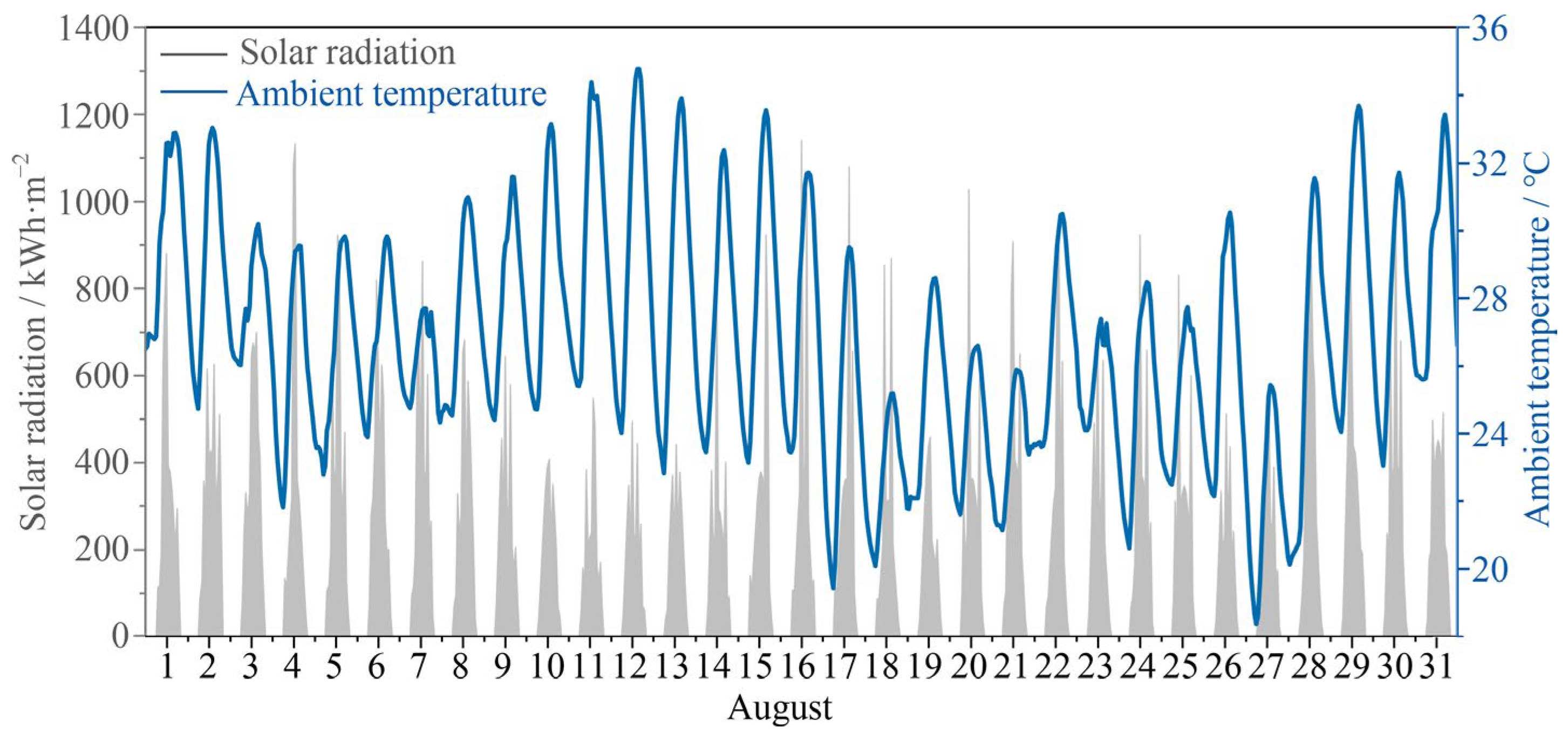
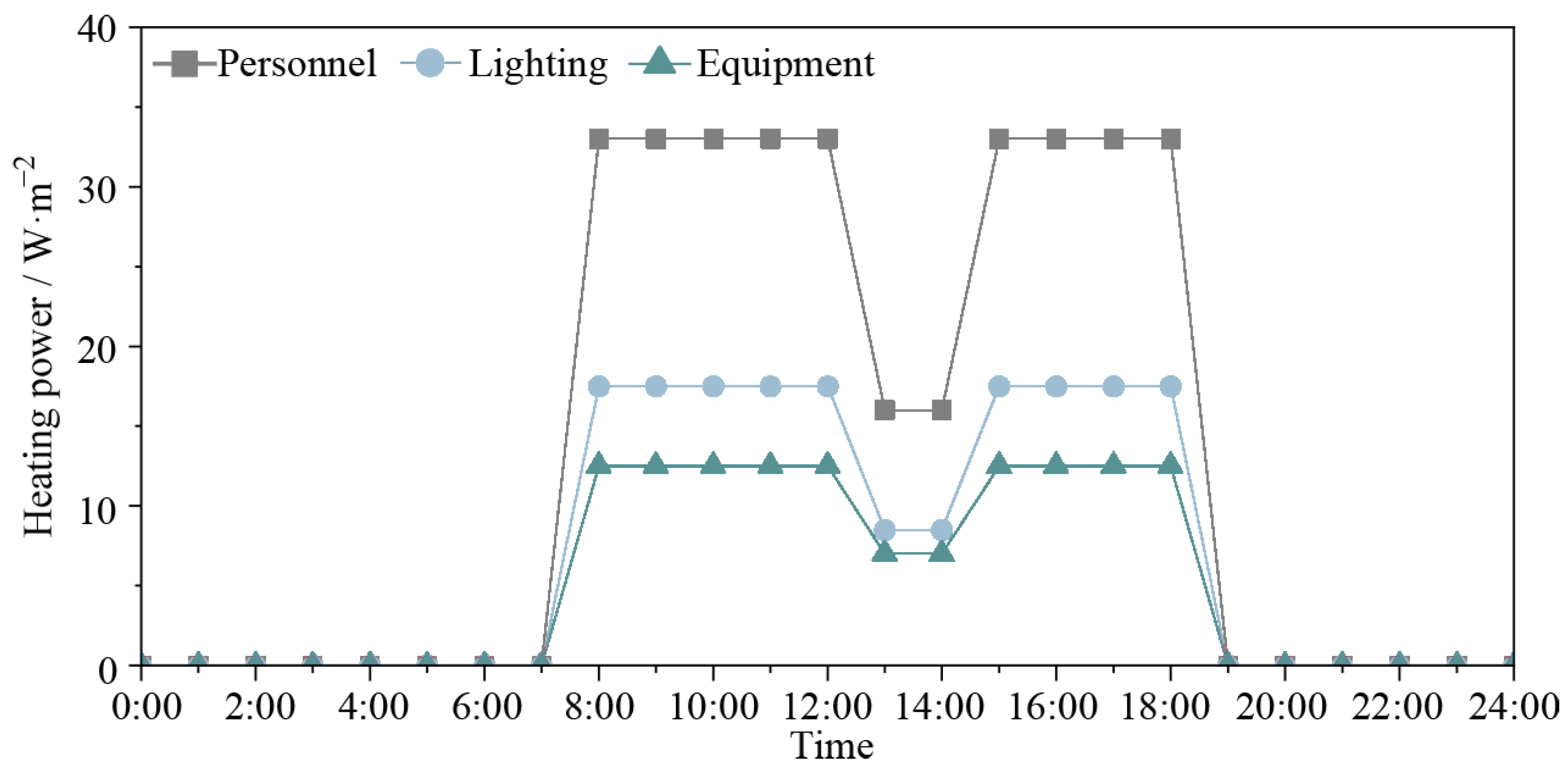
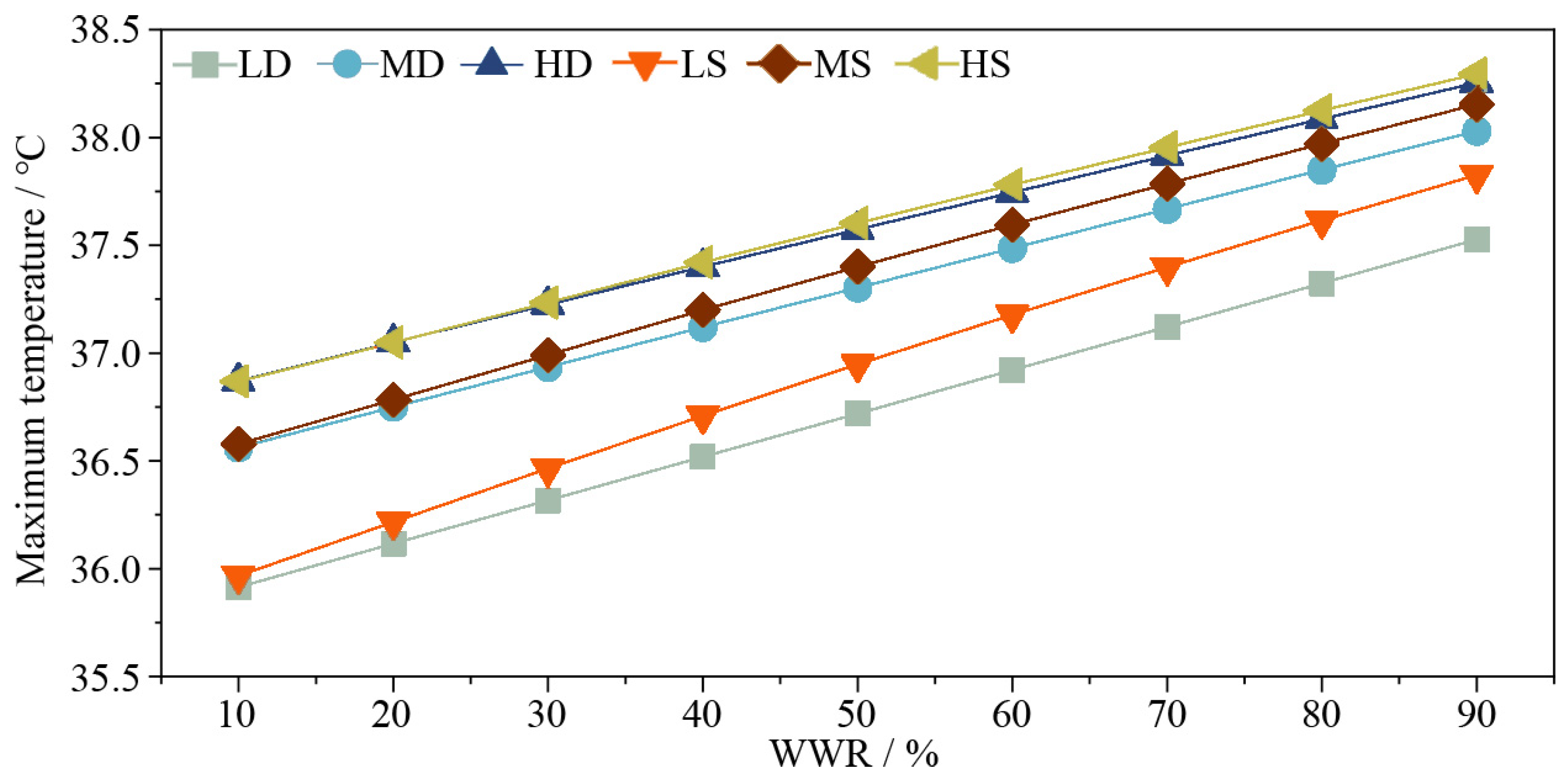

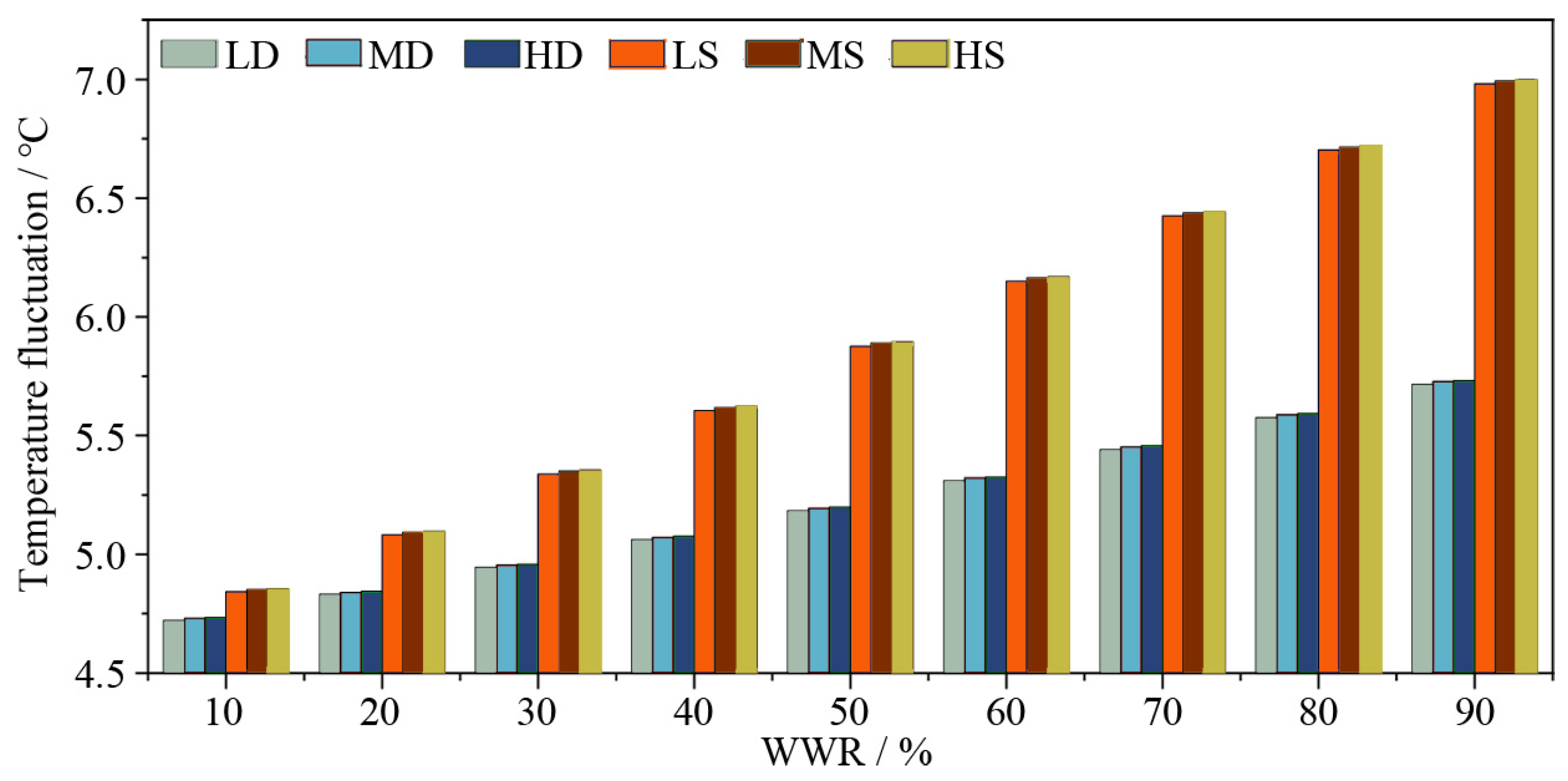
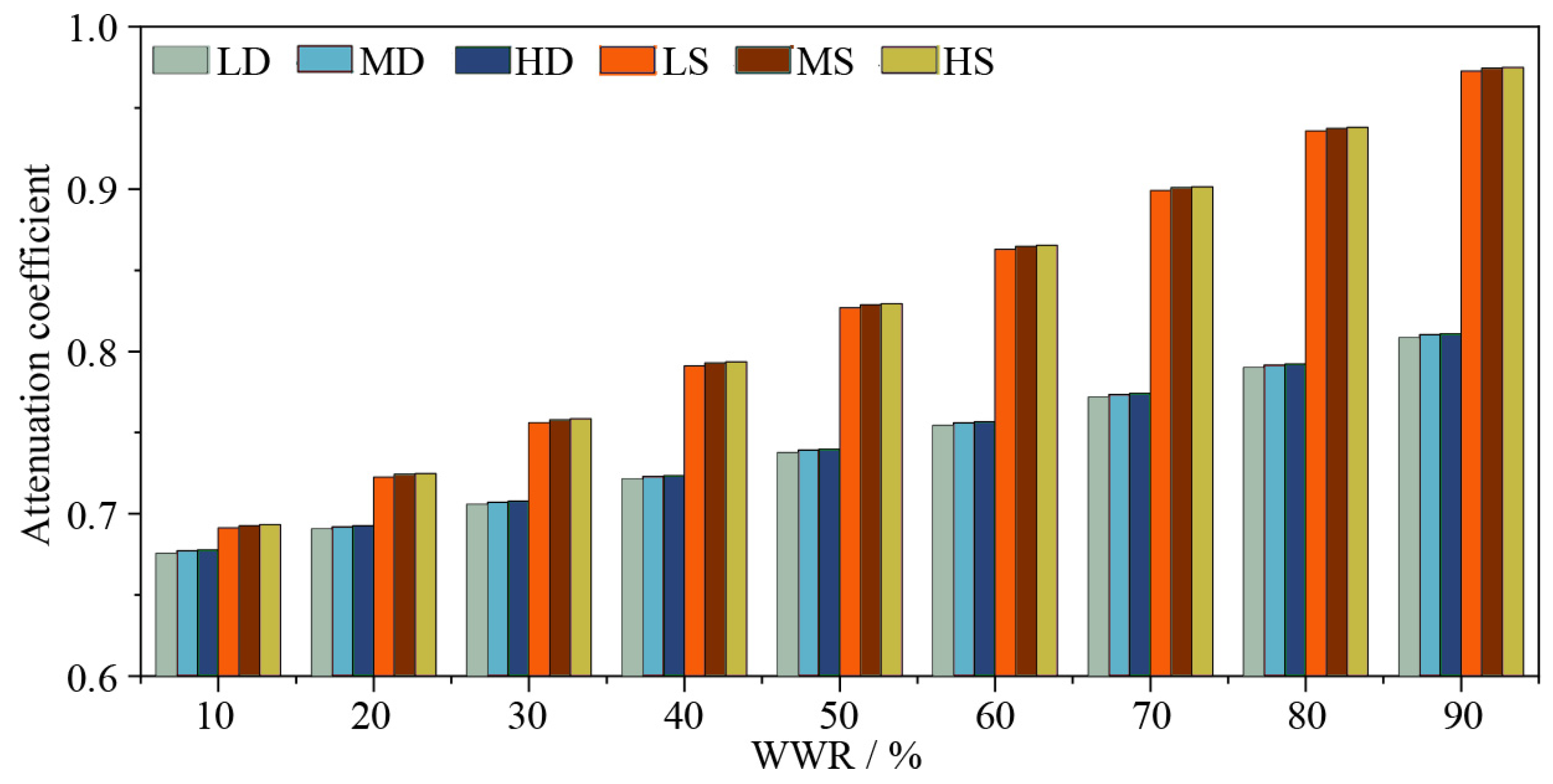
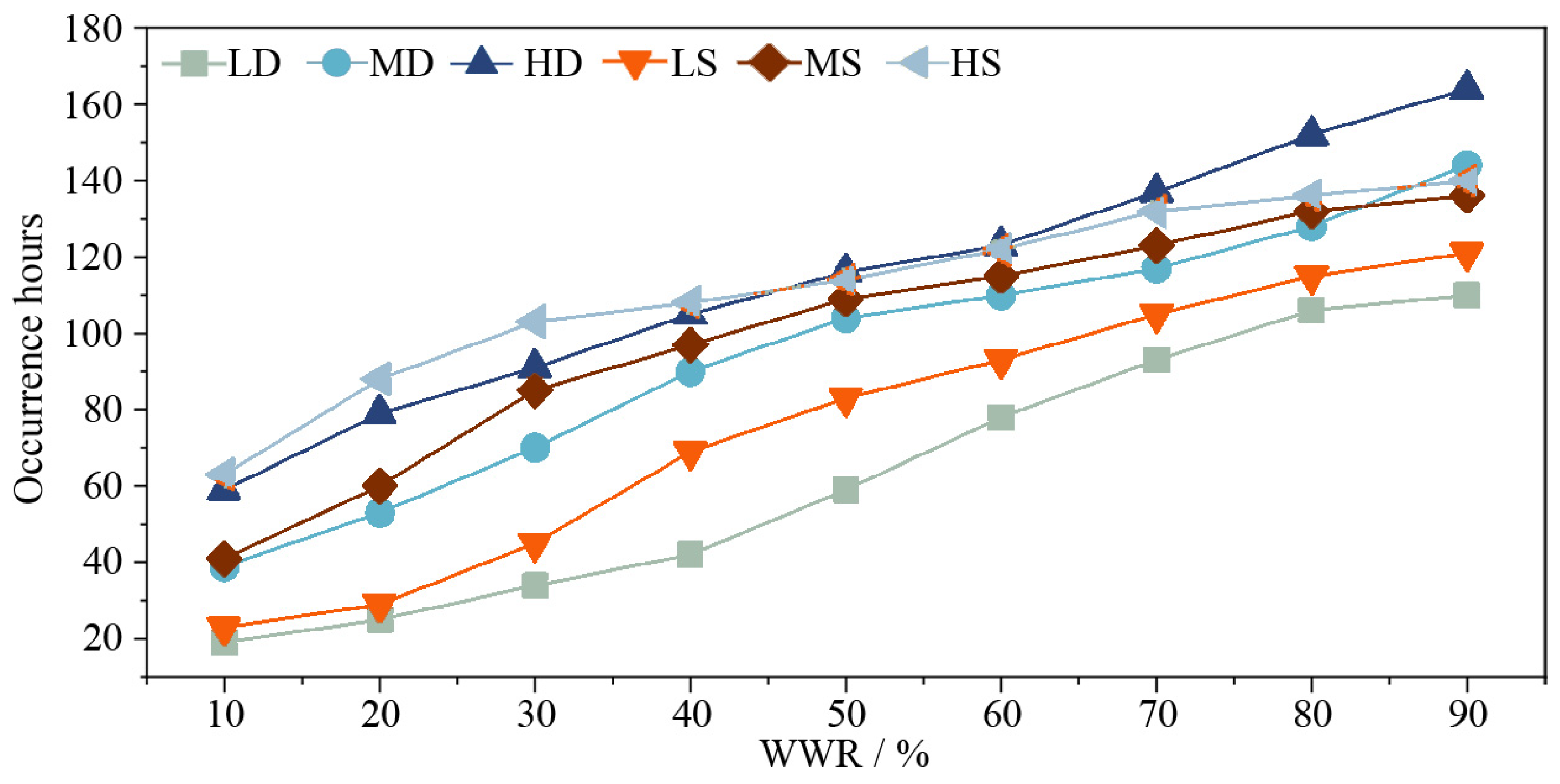
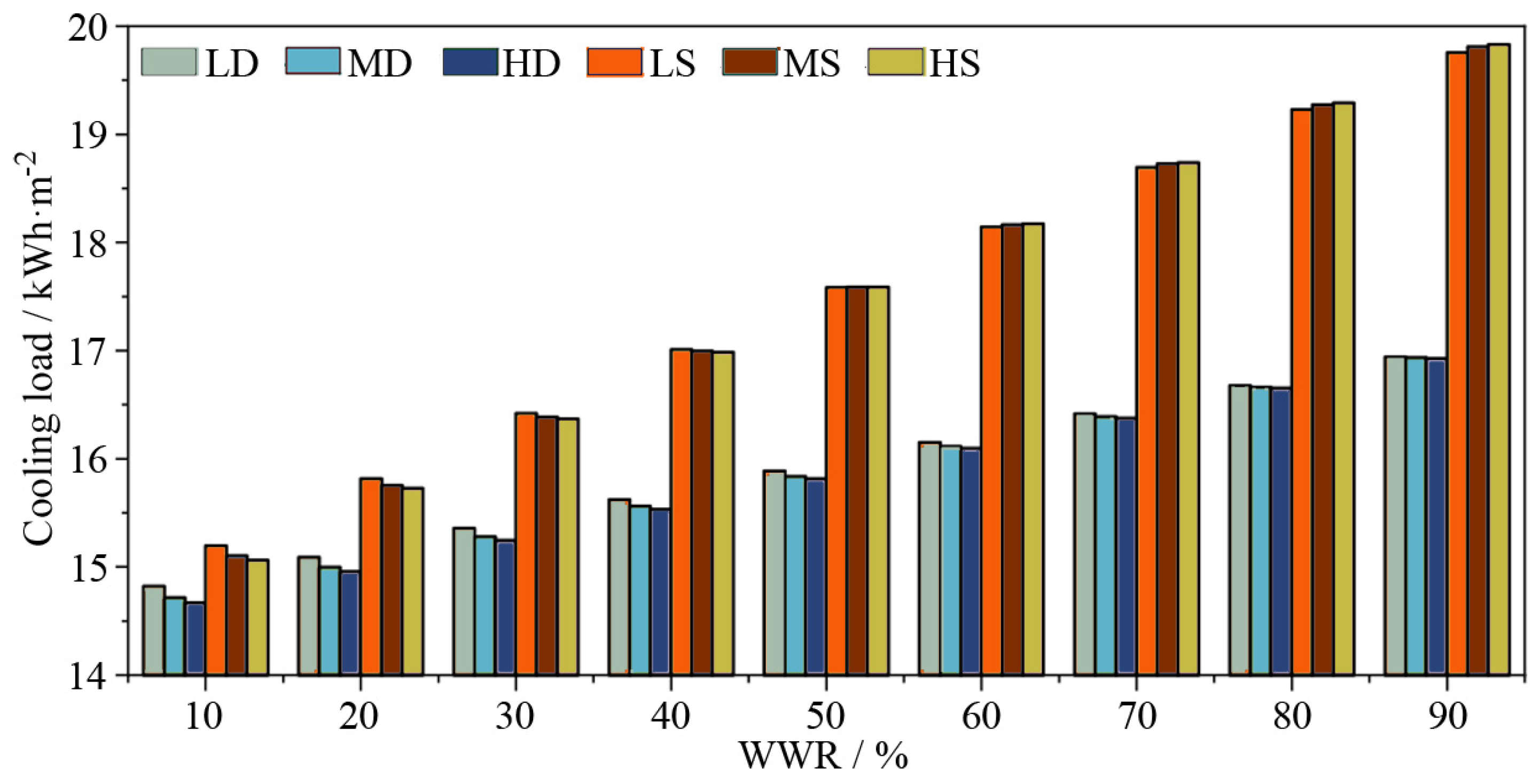
| Type | Layer | Thickness (δ), m | Total Thickness (δ), m | Overall Heat Transfer Coefficient (U), W·m−2K−1 |
|---|---|---|---|---|
| Celling | Expanded polystyrene board | 0.02 | 0.155 | 0.224 |
| Reinforced concrete | 0.12 | |||
| Cement mortar | 0.015 | |||
| Interior wall | Gypsum | 0.012 | 0.074 | 0.652 |
| Insulation | 0.050 | |||
| Gypsum | 0.012 | |||
| Light thermal mass | Plaster | 0.015 | 0.285 | 0.833 |
| Insulation | 0.030 | |||
| Brick | 0.240 | |||
| Medium thermal mass | Plaster | 0.015 | 0.320 | 0.485 |
| Insulation | 0.065 | |||
| Brick | 0.240 | |||
| Heavy thermal mass | Plaster | 0.015 | 0.355 | 0.339 |
| Insulation | 0.100 | |||
| Brick | 0.240 |
| Type | Double 14011 | Single 102 |
|---|---|---|
| Thickness of glass (δ), mm | 26 (6/16/4) | 6 |
| Overall heat transfer coefficient (U), W·m−2K−1 | 1.240 | 5.69 |
| Solar radiation transmissivity | 0.354 | 0.823 |
| Solar radiation reflectivity | 0.321 | 0.072 |
| Visible light transmissivity | 0.529 | 0.855 |
Disclaimer/Publisher’s Note: The statements, opinions and data contained in all publications are solely those of the individual author(s) and contributor(s) and not of MDPI and/or the editor(s). MDPI and/or the editor(s) disclaim responsibility for any injury to people or property resulting from any ideas, methods, instructions or products referred to in the content. |
© 2025 by the authors. Licensee MDPI, Basel, Switzerland. This article is an open access article distributed under the terms and conditions of the Creative Commons Attribution (CC BY) license (https://creativecommons.org/licenses/by/4.0/).
Share and Cite
Cheng, R.; Zhang, N.; Zhang, W.; Sun, Y.; Yin, B.; Gao, W. Impact of Thermal Mass, Window Performance, and Window–Wall Ratio on Indoor Thermal Dynamics in Public Buildings. Buildings 2025, 15, 1757. https://doi.org/10.3390/buildings15101757
Cheng R, Zhang N, Zhang W, Sun Y, Yin B, Gao W. Impact of Thermal Mass, Window Performance, and Window–Wall Ratio on Indoor Thermal Dynamics in Public Buildings. Buildings. 2025; 15(10):1757. https://doi.org/10.3390/buildings15101757
Chicago/Turabian StyleCheng, Ran, Nan Zhang, Wengan Zhang, Yinan Sun, Bing Yin, and Weijun Gao. 2025. "Impact of Thermal Mass, Window Performance, and Window–Wall Ratio on Indoor Thermal Dynamics in Public Buildings" Buildings 15, no. 10: 1757. https://doi.org/10.3390/buildings15101757
APA StyleCheng, R., Zhang, N., Zhang, W., Sun, Y., Yin, B., & Gao, W. (2025). Impact of Thermal Mass, Window Performance, and Window–Wall Ratio on Indoor Thermal Dynamics in Public Buildings. Buildings, 15(10), 1757. https://doi.org/10.3390/buildings15101757





